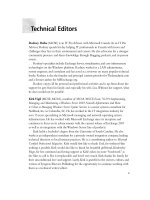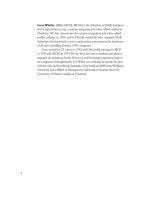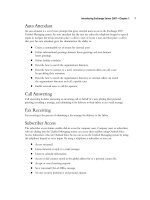Exxhange SQL And IIS- P32 potx
Bạn đang xem bản rút gọn của tài liệu. Xem và tải ngay bản đầy đủ của tài liệu tại đây (493.69 KB, 5 trang )
Managing Recipients in Exchange 2007 • Chapter 3 127
Managing Mail Contacts and Mail Users
We manage mail contacts (mail-enabled contacts) and mail users (mail-enabled users) under the
Mailbox Contact subnode beneath the Recipient Confi guration work center node. So, what is a mail
contact? Most of you should know what it is, since this type of object has existed since Exchange
2000 was released to manufacturing. For those of you who would like a refresher, a mail contact is an
AD object without security principals as well as a mailbox. Because this object doesn’t have any
security principals, it cannot be used to log onto the network and/or be used in an ACL to assign
access to a resource. The purpose of this object is simply to represent an external recipient (using a
name and an external SMTP address) in the Exchange address lists. This could be customer or a
consultant, for example.
A mail user (mail-enabled user) is an object that does have an account in Active Directory as
well as an external e-mail address associated with it, but this type of recipient does not have an
Exchange mailbox in the organization. A mail user is also listed in the Exchange address lists. The only
difference between a mail contact and a mail user is that a mail user can log onto the Active Directory
and can be used in an ACL to gain access to domain resources. Mail users are typically used for
contract employees who are on site for a period of time and require access to the network but want to
use their own mailbox (for example, a mailbox in another Exchange organization that they access
using OWA or Outlook Anywhere) or simply use a messaging system other than Exchange.
fi lter that included all recipients in an OU called EDFUsers, with a mailbox located on a
server called EDFS03, you would need to run the following command:
New-DynamicDistributionGroup -Name “EDFS03 - Mailbox Users”
-OrganizationalUnit EDFSUsers -RecipientFilter “( (RecipientType
-eq ‘UserMailbox’ -and ServerName -eq ‘EDFS03’) -and -not(Name
-like ‘SystemMailbox{*’) )”
When viewing the Filter tab on the Properties page of a dynamic distribution
group, created using a custom fi lter, you will see something similar to the display in
Figure 3.44, showing the complete recipient fi lter.
128 Chapter 3 • Managing Recipients in Exchange 2007
Figure 3.44 The Filter Tab on the Properties Page When a Filter Has Been Created
Through the Exchange Management Shell
As you can see in Figure 3.45, these recipient types are also explicit and therefore differentiated,
using their own icon and recipient type details.
Managing Recipients in Exchange 2007 • Chapter 3 129
Figure 3.45 Mailbox Contact Subnode in the Exchange Management Console
When highlighting an existing mail contact or mail user, we can either disable or remove the Mail
object and/or access its Properties page. As is also the case with a user mailbox, disabling a mail contact or a
mail user will remove the Exchange properties from the object, whereas removing a mail contact or mail
user will instead delete the object entirely in Active Directory, so be careful when using the Remove action.
Creating a Mail Contact
To create mail contacts, you need to click the New Mail Contact link in the Action pane under the Mail
Contact subnode. This will bring up the New Mail Contact Wizard shown in Figure 3.46. Here we
need to select whether we want to create a new mail contact or want to mail-enable an existing contact.
If you select Existing contact you can click the Browse button, bringing up a GUI picker and listing
all contacts that haven’t been mail-enabled. In this example, we’ll select New Contact and click Next.
130 Chapter 3 • Managing Recipients in Exchange 2007
Figure 3.46 Choosing Whether to Create a New Mail-Enabled Contact or
Mail-Enabling an Existing Contact
On the Contact Information page shown in Figure 3.47, we’ll need to enter the account
information that is required to either create a mail contact or mail-enable a contact. We’ll need to
provide things such as name and alias as well as add the external e-mail address we want to associate
with the Mail Contact object. When you have done so, click Next, and then click New on the
Summary page, and fi nally click Finish.
Managing Recipients in Exchange 2007 • Chapter 3 131
Figure 3.47 Creating a New Mail Contact
The process of creating a mail user is almost identical to creating a mail contact, the only
exception being the need to specify the user account information during creation.
To create a new mail-enabled contact via the EMS, use the New-MailContact CMDlet. To modify
this type of recipient, use the Set-MailContact CMDlet. To create a new mail-enabled user via the
EMS, use the New-MailUser CMDlet. To modify this type of recipient, use the Set-MailUser CMDlet.
Managing Disconnected Mailboxes
When you either disable or remove a mailbox, that mailbox will be marked for deletion but will not be
automatically deleted. Instead, it will be kept in the respective Mailbox database for the number of days









